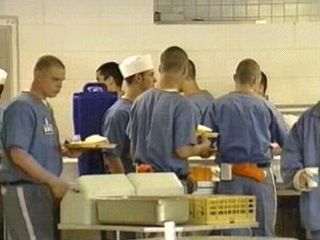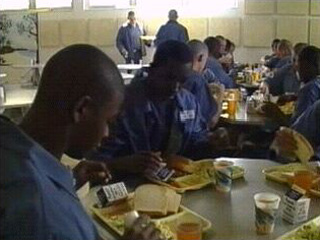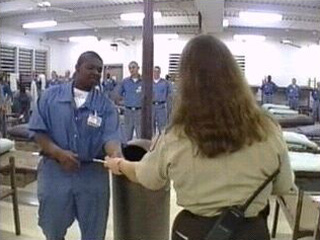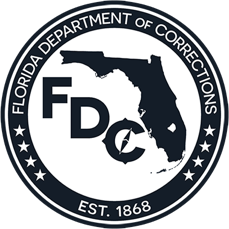1993
OFFENDER POPULATION JUNE 30, 1993:
INMATES: 50,603
SUPERVISED: 129,940
INMATES: 50,603
SUPERVISED: 129,940
The Costello lawsuit is resolved.
 Click here to hear Secretary Harry K. Singletary discuss the Costello lawsuit.
Click here to hear Secretary Harry K. Singletary discuss the Costello lawsuit.
Legislature authorizes funding for 10,584 new beds.
Probation and Restitution Centers (PRCs) are transferred from Community Facilities to Probation and Parole Services, reporting directly to the Circuit Administrator. There are 10 centers with a bed capacity of 380 each.
Partnerships are established with community treatment resources (using in excess of $6 million in state appropriations and federal grant dollars) to provide substance abuse, education, vocational and employment assistance to supervised offenders. More than 15,000 offenders receive conventional or other forms of outpatient intervention services.
Florida C.I. opens "Small Strides" daycare center for the children of employees in this rural area (Lowell). While employees appreciate the convenience of having a daycare center near their workplace, the center loses money from its inception due to low enrollment and is closed in early 1998. A similar situation occurred with the daycare center at Broward Correctional Institution.
Eighteen non-secure residential drug treatment programs in 14 judicial circuits with a total of 710 beds are established.
The Florida Correctional Privatization Commission (CPC) is established by the Correctional Privatization Act of 1993 and is housed administratively within the Department of Management Services. This Commission is not a division of the Florida Department of Corrections. Its purpose is to contract with the private sector to build and operate prisons at a cost of at least seven percent less than the state. In May 2023, there were six private facilities in Florida. They are Bay Correctional Facility, Lake City Correctional Facility, Gadsden Correctional Facility, Moore Haven Correctional Facility, South Bay Correctional Facility, and Graceville Correctional Facility.
On June 30th, community supervision reports approximately 1,000 offenders on electronic monitoring units; over 200,000 investigations and the collection of almost $47 million for the year; 3,521 staff in more than 150 offices.
The average percentage of sentence served by inmates released as of June 30 is 37.0%, a three percentage point increase from the previous year.
1994
OFFENDER POPULATION JUNE 30, 1994:
INMATES: 56,052
SUPERVISED: 133,666
INMATES: 56,052
SUPERVISED: 133,666
The Florida legislature authorizes funding for 17,033 new beds and revises sentencing guidelines for the first time since 1983. The Office of Probation & Parole will be responsible for preparing all guidelines scoresheets statewide, with an estimated workload of approximately 120,000 scoresheet investigations.
The Florida Department of Juvenile Justice (DJJ) is created. According to the Florida Corrections Commission's 2001 Annual Report: "The Juvenile Justice Act of 1994 removed the responsibilities for overseeing juvenile justice from HRS and created a new state agency, the Department of Juvenile Justice effective October 1, 1994. The Secretary of the department, appointed by the Governor, was charged with planning for and managing all programs and services in the juvenile justice system. These programs included prevention, Children-In-Need-of-Services (CINS), Families-In-Need-of-Services (FINS), intervention and diversion, case management, detention care, contracted community-based commitment programs, state-operated juvenile justice institutions and facilities, and aftercare programming." The creation of DJJ may have diverted some offenders who would normally go into the state prison system into DJJ. However, offenders who are juveniles (age 17 or younger when they commit their crimes) who are sentenced as adults continue to be placed in the Department of Corrections prison system.
In response to the Florida Sexual Predator Act, the Office of Probation & Parole Services implements procedures to automate Florida Crime Information Computer (FCIC) offender identification information. By the end of the fiscal year, approximately 450 offenders who potentially meet the criteria as sexual predators are identified.
Several Circuit Pre-Trial Intervention (PTI) Drug Courts are implemented.
On October 17, 1994, the new cost of supervision declining balance policy becomes a part of the Court-Ordered Payment System (COPS). This eliminates the need for a separate billing, receipting and disbursement system.
Prison construction begins using precast concrete cells.
 Click here to listen to Secretary Harry K. Singletary discuss ending Control Release.
Click here to listen to Secretary Harry K. Singletary discuss ending Control Release.
In December 1994, the era of early release credits is over when the latest form of early release, Control Release, ends a full year earlier than anticipated. This is due to both a reduction in prison admissions, and to a massive and accelerated prison-building program. For the first time in years, there is enough prison space to house all the offenders sentenced to prison, and there is no need to let any out early to make room for incoming inmates. The following year, the Legislature will further dismay future inmates by passing a law requiring all inmates who commit crimes on or after October 1, 1995 to serve a minimum of 85% of their sentences. For inmates used to serving 30 or 40 percent of their sentences, and not used to reading the papers, this new law came as an unpleasant surprise at sentencing.
Washington Correctional Institution (Chipley, FL) and (later renamed and repurposed as Northwest Florida Reception Center) and Taylor Correctional Institution (Perry, FL) open.
The average percentage of sentence served by inmates released as of June 30 is 43.1%, a six percentage point increase from the previous year.

Dieticians now provide menus for inmate nutrition.

Inmates designated as youthful offenders must be given milk daily.

Officer handing out mail
- 1821-1845
- 1868-1876
- 1877-1895
- 1900-1919
- 1921
- 1922-1924
- 1927
- 1928-1931
- 1932 | CHAPMAN
- 1933-1935
- 1936-1939
- 1940-1945
- 1946-1949
- 1950-1955
- 1956-1961
- 1962 | WAINWRIGHT
- 1963-1965
- 1966-1969
- 1970-1975
- 1976-1979
- 1980-1986
- 1987 | DUGGER
- 1988-1990
- 1991 | SINGLETARY
- 1992-1995
- 1996-1998
- 1999 | MOORE
- 2000-2002
- 2003 | CROSBY
- 2004-2005
- 2006 | MCDONOUGH
- 2007
- 2008 | MCNEIL
- 2009-2010
- 2011 | BUSS
- 2011 | TUCKER
- 2012 | CREWS
- 2013-2014
- 2014 | JONES
- 2015-2018
- 2019 | INCH
- 2020-2021
- 2021 | DIXON
- 2022-Today
- Population Summary Table

